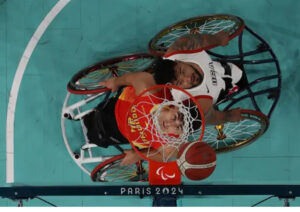In Horse and Rider (2004), Richard Hambleton doesn’t just paint a scene—he conjures a reckoning. A black figure on horseback charges into the frame like a specter torn from myth and backdrop, a blur of motion frozen in acrylic. The brushstrokes are violent and raw, a detonation of ink and movement that captures not just an image, but a force. To understand Horse and Rider is to understand Hambleton: street art’s ghostly pioneer, a man who made New York’s walls scream and whisper, who marked the city with the urgency of someone running out of time.
At a glance, Horse and Rider resembles an eruption—an equestrian silhouette contorted mid-gallop, clawing through the canvas as if trying to escape it. The image pulses with threat and velocity, a feral energy that refuses domestication. There’s no face, no eye contact, no narrative comfort. The rider isn’t a hero; the horse isn’t tamed. This is motion distilled into chaos. But chaos, for Hambleton, was never gratuitous. It was anatomical. Fundamental. Born of both the streets and the studio, his figures speak not in words but in ruptures. And Horse and Rider may be his most elegiac rupture of all.
From the Alley to the Canvas
Richard Hambleton’s name does not appear in art history textbooks with the same frequency as Keith Haring or Jean-Michel Basquiat, but his influence is just as foundational. If Basquiat was the poet and Haring the prophet, Hambleton was the phantom—the dark figure watching from the alley, splashing silhouettes on brick and concrete like warnings or prophecies.
His “Shadowmen,” sprayed or painted in the 1980s across Lower Manhattan, were not just tags—they were confrontations. Abrupt, disquieting, often mistaken for real people at night, they introduced a new language to urban art. Unlike graffiti, which often focused on style and name, Hambleton’s work focused on presence. His figures didn’t want to be recognized; they wanted to unsettle.
Horse and Rider evolves directly from the Shadowman DNA. The stark black form, the lack of detail, the kinetic explosiveness—they’re all remnants of his earlier wall haunts. But the transition to canvas in the 2000s allowed him to stretch these figures out, to embed them deeper into paint, to manipulate texture and weight with more control. Still, the energy remained untamed. Like a storm carried indoors.
The Violence of Form
There’s nothing polite about Horse and Rider. The painting assaults the eye with jagged strokes, with a horse that seems more specter than stallion. Its legs blur into the void, the rider barely clings on. The anatomy is there but deliberately obscured, destabilized. It feels as if the figure was conjured in a panic, or mid-fall. This is not equestrianism as grace—it is survival.
This sense of instability mirrors Hambleton’s own life. By the time he painted Horse and Rider, Hambleton was deep in the backgrounds of addiction, health complications, and marginalization from the mainstream art world. He had already burned bridges, alienated supporters, and become, in many ways, a myth within the art scene—a name whispered with reverence and pity. The horse and rider become symbolic: two entities barreling into uncertainty, unable to stop, unwilling to fall.
There’s also something post-apocalyptic about the image. The horse doesn’t gallop through pastoral plains—it tears through an infernal landscape, its hooves kicking up ash. It recalls the Four Horsemen of the Apocalypse, particularly Death. In this reading, the rider isn’t a figure of control but a passenger on a beast that represents time, entropy, or collapse. This makes Horse and Rider less of an equestrian portrait and more of a death fugue, an anthem for the damned.
Against the Polished World
One reason Hambleton fell out of favor in the 1990s and early 2000s was his unwillingness—or inability—to play the game. The art world, increasingly professionalized and market-oriented, had little patience for an erratic, hard-living street artist whose best work was often hidden behind dumpsters or under bridges. Hambleton was volatile, combative, and often self-destructive. His health—ravaged by skin cancer, scoliosis, and substance abuse—mirrored his canvases: broken, burning, still somehow standing.
But this resistance to polish is exactly what gives Horse and Rider its power. While contemporaries moved into clean lines and curated spaces, Hambleton dragged his ghosts into the gallery kicking and screaming. The paint is still street paint. The gestures are still from the wrist of a man who tagged walls in fear of being arrested. There is no elegance here, only urgency.
This puts Hambleton in a peculiar place. He’s a studio artist who never stopped being a vandal. And Horse and Rider carries that defiance. It refuses categorization. Is it painting? Is it performance? Is it protest? Is it a cry for help? It’s all of them—and more honest because of it.
Legacy in Silhouette
In recent years, Hambleton’s reputation has experienced a cautious resurrection. His inclusion in major museum collections like MoMA and the Andy Warhol Museum reflects a broader re-evaluation of street art as serious art. The prices of his works now routinely breach six figures at auction, and the myth of the “Shadowman” has only deepened with his death in 2017.
But even amid this resurgence, Horse and Rider remains a particularly haunting relic—not just because of its aesthetic violence, but because it encapsulates the contradiction at Hambleton’s core. He was a pioneer of visibility who often wanted to disappear. A man who painted massive figures on walls yet shunned fame. His work was always about edges—between life and death, fame and ruin, motion and collapse.
The horse in Horse and Rider has no ground. There’s no floor beneath it. No stable. It runs nowhere, toward nothing. It is free and damned. That’s Hambleton, too.
Art of Absence
What makes Horse and Rider particularly potent is not just what’s present but what’s missing. There’s no color beyond black. No horizon. No context. The rider is faceless, genderless. The horse is half-formed, part-animal, part-phantom. Everything about the image invites absence. It’s a painting about what’s not there.
This aesthetic of absence is consistent throughout Hambleton’s oeuvre. His Shadowmen were always less about the figure and more about the void they suggested—the fear of someone watching, or someone lost. His figures loomed because they were undefined. The same goes for Horse and Rider. It is not a depiction of a man on a horse; it’s the outline of a moment that’s already passed. The painting doesn’t invite us to admire it. It dares us to try and hold onto it, as it fades.
Street Art’s Ghost
To call Richard Hambleton the “godfather of street art” is accurate but insufficient. He wasn’t just first—he was different. His work wasn’t about style or signature. He never sought brand recognition like later street artists. He didn’t want to be seen; he wanted his figures to be felt. That’s the key distinction. While the art world canonized Basquiat as the saint of urgency and Haring as the prophet of joy, Hambleton remained the ghost. He walked the same streets, painted the same walls, but he always pointed away from himself. Toward the dark corners. Toward the inevitable.
Horse and Rider, then, is a kind of epitaph. Not just for Hambleton’s career, which flared and faded and flared again. But for a style of art that refused to be tamed. It’s a warning against forgetting, a reminder that the most potent art often comes not from success but from struggle.
Galloping Toward Oblivion
In Horse and Rider (2004), Hambleton created more than a painting—he summoned an icon. The image is simple: black paint on canvas, man and beast in violent motion. But within that simplicity is an ocean of complexity: a life spent in motion, a legacy built in shadows, an artist chasing—and being chased by—his own myth.
Hambleton’s Horse and Rider does not seek admiration. It isn’t there to be understood. It’s there to be felt in the gut, like a storm passing through your ribcage. It is fear. It is flight. It is every moment of collapse rendered with beauty and brutality.
The horse will not stop. The rider cannot dismount. Together, they charge into the night, a silhouette torn from the bones of the city.
No comments yet.








